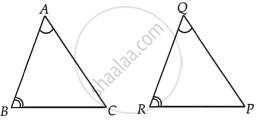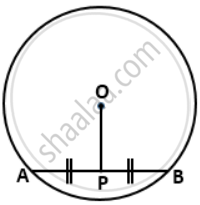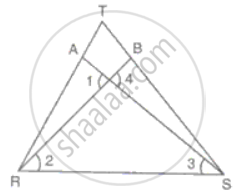Advertisements
Advertisements
प्रश्न
In triangles ABC and PQR, ∠A = ∠Q and ∠B = ∠R. Which side of ∆PQR should be equal to side AB of ∆ABC so that the two triangles are congruent? Give reason for your answer.
उत्तर
We have given, in ΔABC and ΔPQR, ∠A = ∠Q and ∠B = ∠R

Since, AB and QR are included between equal angles.
Hence, the side of ΔPQR is QR which should be equal to side AB of ΔABC, so that the triangles are congruent by the rule ASA.
APPEARS IN
संबंधित प्रश्न
If ΔDEF ≅ ΔBCA, write the part(s) of ΔBCA that correspond to ∠E
In triangles ABC and PQR three equality relations between some parts are as follows:
AB = QP, ∠B = ∠P and BC = PR
State which of the congruence conditions applies:
In the following example, a pair of triangles is shown. Equal parts of triangles in each pair are marked with the same sign. Observe the figure and state the test by which the triangle in each pair are congruent.

By ______ test
Δ ABC ≅ ΔPQR
In the following figure, OA = OC and AB = BC.

Prove that: AD = CD
In the given figure P is a midpoint of chord AB of the circle O. prove that OP ^ AB.
In the figure, RT = TS, ∠1 = 2∠2 and ∠4 = 2∠3. Prove that ΔRBT ≅ ΔSAT.
O is any point in the ΔABC such that the perpendicular drawn from O on AB and AC are equal. Prove that OA is the bisector of ∠BAC.
“If two sides and an angle of one triangle are equal to two sides and an angle of another triangle, then the two triangles must be congruent.” Is the statement true? Why?
It is given that ∆ABC ≅ ∆RPQ. Is it true to say that BC = QR? Why?
If ∆PQR is congruent to ∆STU (see figure), then what is the length of TU?

